英语小升初专项复习——名词 课件(共22张PPT)
文档属性
| 名称 | 英语小升初专项复习——名词 课件(共22张PPT) | 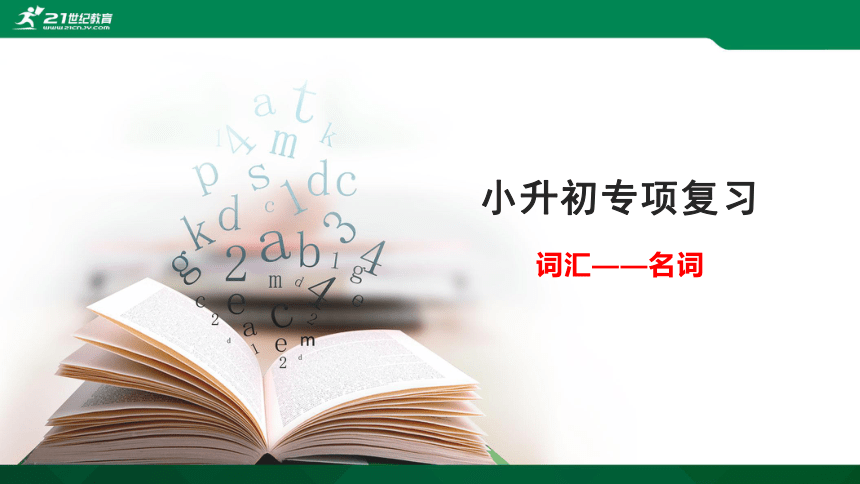 | |
| 格式 | zip | ||
| 文件大小 | 3.4MB | ||
| 资源类型 | 试卷 | ||
| 版本资源 | 通用版 | ||
| 科目 | 英语 | ||
| 更新时间 | 2020-06-23 07:27:17 | ||
图片预览

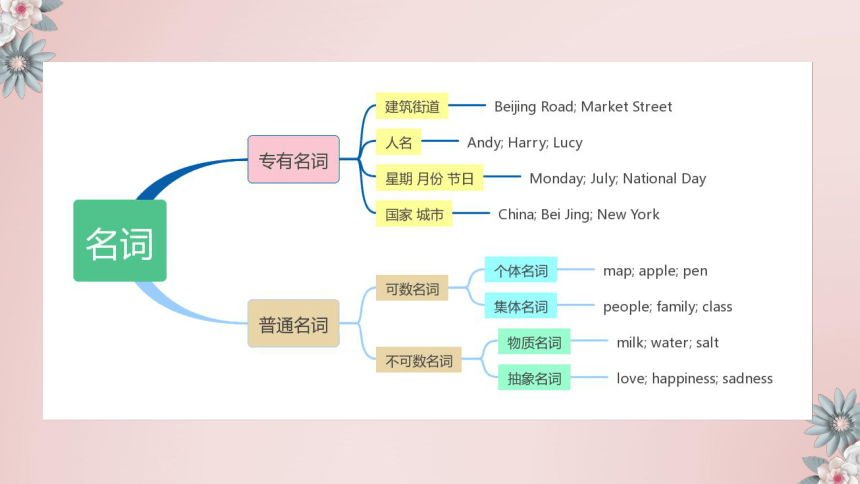
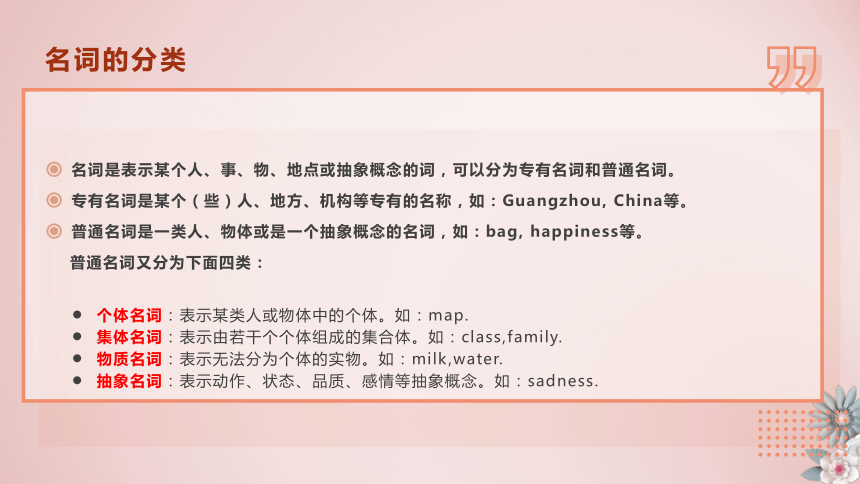
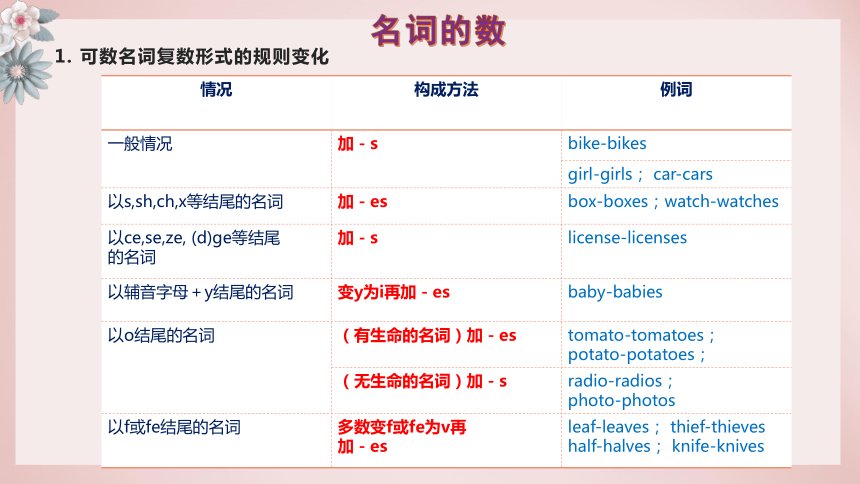
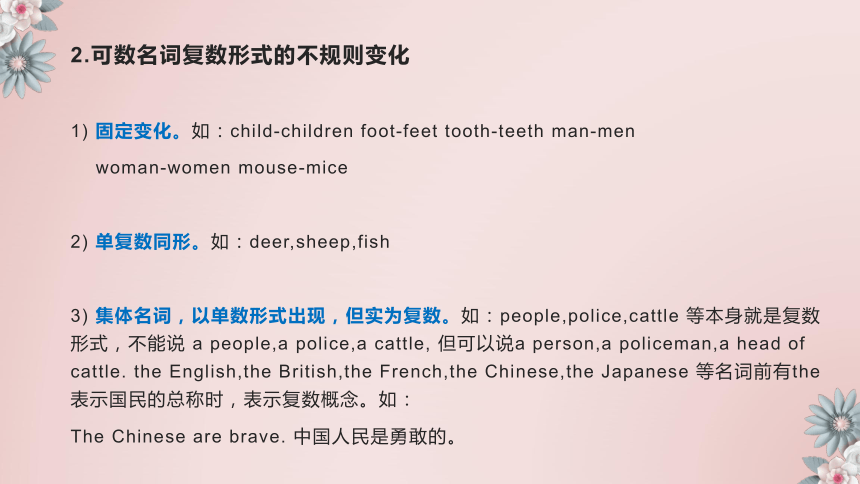

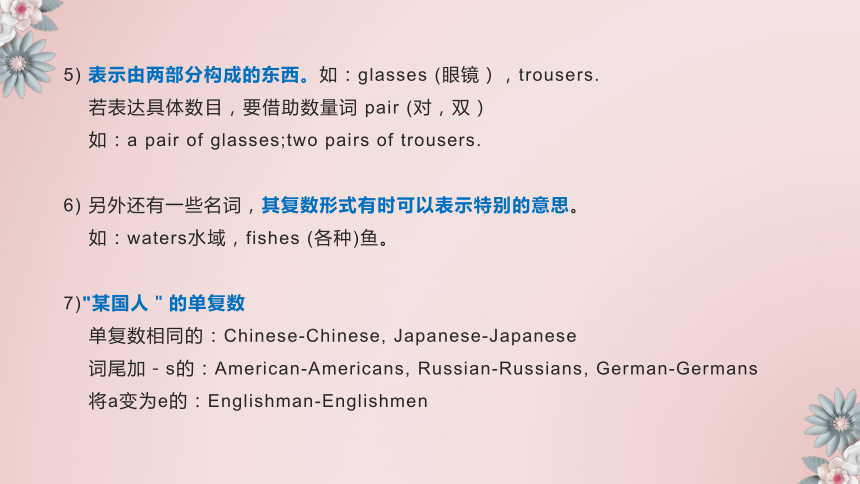
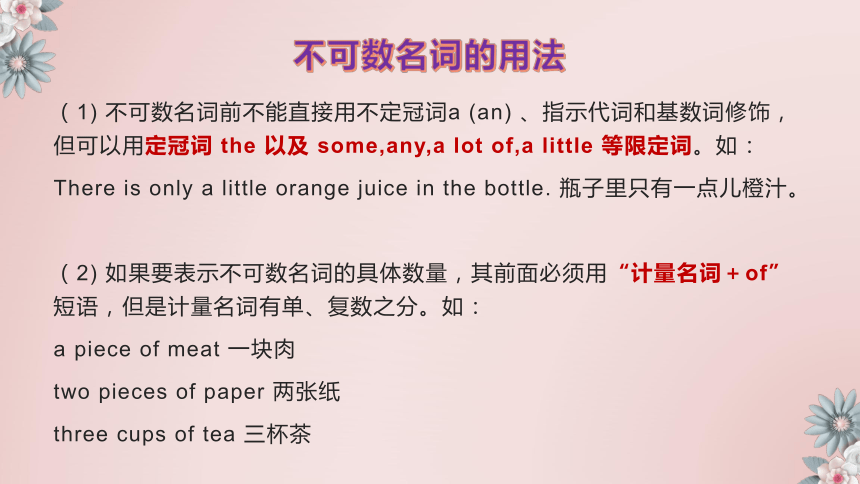
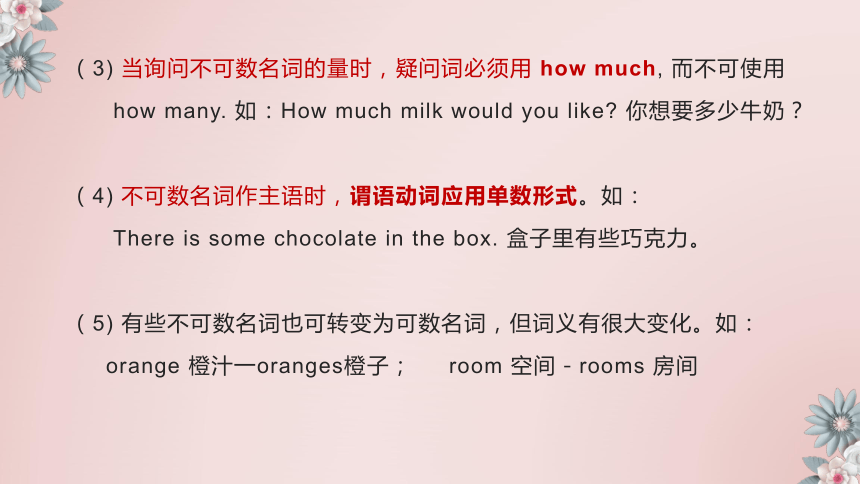
文档简介
(共22张PPT)
小升初专项复习
词汇——名词
名词是表示某个人、事、物、地点或抽象概念的词,可以分为专有名词和普通名词。
专有名词是某个(些)人、地方、机构等专有的名称,如:Guangzhou,
China等。
普通名词是一类人、物体或是一个抽象概念的名词,如:bag,
happiness等。
普通名词又分为下面四类:
个体名词:表示某类人或物体中的个体。如:map.
集体名词:表示由若干个个体组成的集合体。如:class,family.
物质名词:表示无法分为个体的实物。如:milk,water.
抽象名词:表示动作、状态、品质、感情等抽象概念。如:sadness.
名词的分类
名词的数
1.
可数名词复数形式的规则变化
情况
构成方法
例词
一般情况
加-s
bike-bikes
girl-girls;
car-cars
以s,sh,ch,x等结尾的名词
加-es
box-boxes;watch-watches
以ce,se,ze,
(d)ge等结尾
的名词
加-s
license-licenses
以辅音字母+y结尾的名词
变y为i再加-es
baby-babies
以o结尾的名词
(有生命的名词)加-es
tomato-tomatoes;
potato-potatoes;
(无生命的名词)加-s
radio-radios;
photo-photos
以f或fe结尾的名词
多数变f或fe为v再
加-es
leaf-leaves;
thief-thieves
half-halves;
knife-knives
2.可数名词复数形式的不规则变化
1)
固定变化。如:child-children
foot-feet
tooth-teeth
man-men
woman-women
mouse-mice
2)
单复数同形。如:deer,sheep,fish
3)
集体名词,以单数形式出现,但实为复数。如:people,police,cattle
等本身就是复数形式,不能说
a
people,a
police,a
cattle,
但可以说a
person,a
policeman,a
head
of
cattle.
the
English,the
British,the
French,the
Chinese,the
Japanese
等名词前有the表示国民的总称时,表示复数概念。如:
The
Chinese
are
brave.
中国人民是勇敢的。
4)
以s结尾,仍为单数的名词。如:
maths,politics,physics
等学科名词,为不可数名词,是单数。
news
是不可数名词。
the
United
States,
the
United
Nations
应视为单数。如:
The
United
Nations
was
organised
in
1945.
联合国是
1945年组建起来的。
④
以复数形式出现的书名、剧名、报纸、杂志名,也可视为单数。如:
The
Arabian
Nights《一千零一夜》
5)
表示由两部分构成的东西。如:glasses
(眼镜),trousers.
若表达具体数目,要借助数量词
pair
(对,双)
如:a
pair
of
glasses;two
pairs
of
trousers.
6)
另外还有一些名词,其复数形式有时可以表示特别的意思。
如:waters水域,fishes
(各种)鱼。
7)"某国人"的单复数
单复数相同的:Chinese-Chinese,
Japanese-Japanese
词尾加-s的:American-Americans,
Russian-Russians,
German-Germans
将a变为e的:Englishman-Englishmen
不可数名词的用法
(1)
不可数名词前不能直接用不定冠词a
(an)
、指示代词和基数词修饰,但可以用定冠词
the
以及
some,any,a
lot
of,a
little
等限定词。如:
There
is
only
a
little
orange
juice
in
the
bottle.
瓶子里只有一点儿橙汁。
(2)
如果要表示不可数名词的具体数量,其前面必须用“计量名词+of”短语,但是计量名词有单、复数之分。如:
a
piece
of
meat
一块肉
two
pieces
of
paper
两张纸
three
cups
of
tea
三杯茶
(3)
当询问不可数名词的量时,疑问词必须用
how
much,
而不可使用
how
many.
如:How
much
milk
would
you
like?
你想要多少牛奶?
(4)
不可数名词作主语时,谓语动词应用单数形式。如:
There
is
some
chocolate
in
the
box.
盒子里有些巧克力。
(5)
有些不可数名词也可转变为可数名词,但词义有很大变化。如:
orange
橙汁一oranges橙子;
room
空间-rooms
房间
名词的所有格
名词所有格的规则如下:
(1)
单数名词词尾加“'s”,
复数名词词尾没有s,
也要加“'s”。
如:
the
teacher's
desk,
Children's
Day,
Women's
Day.
(2)
若名词已有复数词尾-s,
只加“’”,
如:the
Teachers'
Day.
(3)
没有生命的名词的所有格一般不能加“'s”,
可以用“名词+of+名词”的结构来表示所有关系,但也有少数特殊情况。如:five
minutes'
walk,today's
newspaper.
(4)
在表示店铺或教堂的名字或某人的家时,名词所有格的后面常常不出现它所修饰的名词。如:the
barber's
理发店。
(5)
如果两个名词并列,并且分别有's,
则表示“分别有”;
若只有一个's,
则表示“共有”。
如:John's
and
Tom's
rooms
(约翰的房间和汤姆的房间),
John
and
Tom's
room
(约翰和汤姆的房间)。
Exercise
一、写出下列名词的复数形式
1.
boy
_______
2.
photo
______
3.
family
_______
4.
teacher
_______
5.
tomato
_______
6.
knife
_______
7.
child
_______
8.
dog
_______
9.
watch
_______
10.
tooth
_______
11.
man
_______
12.
Chinese
_______
13.
mouse
_______
14.
sheep
_______
15.
bird
_______
16.
bus
_______
boys
photos
families
teachers
tomatoes
knives
children
dogs
watches
teeth
men
Chinese
mice
sheep
birds
buses
二、选出与其他不是同类的一项
(
)
1.
A.pig
B.
dog
C.
bag
D.
cow
(
)
2.
A.
worker
B.
farmer
C.
teacher
D.
sister
(
)
3.
A.
pear
B.
orange
C.
cabbage
D.
grape
(
)
4.
A.
children
B.
bird
C.
fish
D.
sheep
(
)
5.
A.
basketball
B.
football
C.
book
D.
ping-pong
C
D
C
A
C
三、单项选择
(
)
1.
Water
_____
very
important
for
us.
A.
are
B.
is
C.
be
(
)
2.
—Who
is
that
_____?
—She
is
my
aunt.
A.
man
B.
woman
C.
women
(
)
3.
Happy
_____
Day!
A.
Child
B.
Children
C.
Children's
(
)
4.
—Which
_____
do
you
like
best?
—Spring.
A.
season
B.
coat
C.
sport
(
)
5.
—Who
is
Mr.
White?
—He
is
_____
father.
A.
Tom
and
Luch
B.
Tom's
and
Lucy's
C.
Tom
and
Lucy's
B
B
C
A
C
(
)
6.
I
need
to
look
after
those
_____.
A.
sheep
B.
animal
C.
flower
(
)
7.
Henry
went
to
her
_____
house
yesterday.
A.
grandparents
B.
grandparents'
C.
grandparent
(
)
8.
There
_____
a
cup
of
tea
on
the
table.
A.
be
B.
is
C.
are
(
)
9.
Mr.
Wang
is
a
teacher,
he
works
in
a
_____.
A.
farm
B.
hospital
C.
school
(
)
10.
Amy
is
my
uncle's
_____.
She
is
my
cousin.
A.
daughter
B.
son
C.
sister
A
B
B
C
A
四、用所给名词的适当形式填空
1.
There
is
some
_____
(bread)
in
the
bag.
2.
An
elephant
has
_____
(foot).
3.
He
has
three
_____
(bottle)
of
_____
(orange).
4.
They
are
________
(policeman).
5.
Lucy
likes
collecting
_____________
(Chinese
stamp).
bread
feet
bottles
orange
policemen
Chinese
stamps
6.
Lots
of
_____
(fish)
are
swimming
in
the
pool.
7.
The
white
_____
(shoe)
are
_____
(Toby)
_____
(father).
8.
How
many
______
(child)
are
there
in
the
classroom?
9.
There
are
twelve
_____
(deer)
in
teh
zoo.
10.
This
is
___________
(
Mike
and
Tom)
room.
fish
shoes
Toby's
father's
children
deer
Mike
and
Tom's
五、将下列句子的单复数形式互换
1.
This
is
a
flower.
__________________
2.
This
is
a
sheep.
__________________
3.
This
is
my
dress.
__________________
4.
Those
are
Chinese.
__________________
5.
These
thieves
are
very
clever.
_________________________
These
are
flowers.
These
are
sheep.
These
are
my
dresses.
This
is
a
Chinese.
This
thief
is
very
clever.
五、圈出下列句子中的错误,并在横线上改正
1.
There
are
many
policemans.
____________________
2.
We
brush
our
tooth
every
day.
____________________
3.
I
can
see
lots
of
sheep
on
the
farmer.
___________________
4.
Look
at
the
mouses
in
that
box.
_____________________
5.
The
deers
are
playing
with
their
mother.
___________________
policemans
改为
policemen
tooth
改为
teeth
farmer
改为
farm
mouses
改为
mice
deers
改为
deer
Thank
you!
谢谢
21世纪教育网(www.21cnjy.com)
中小学教育资源网站
有大把高质量资料?一线教师?一线教研员?
欢迎加入21世纪教育网教师合作团队!!月薪过万不是梦!!
详情请看:
https://www.21cnjy.com/help/help_extract.php
小升初专项复习
词汇——名词
名词是表示某个人、事、物、地点或抽象概念的词,可以分为专有名词和普通名词。
专有名词是某个(些)人、地方、机构等专有的名称,如:Guangzhou,
China等。
普通名词是一类人、物体或是一个抽象概念的名词,如:bag,
happiness等。
普通名词又分为下面四类:
个体名词:表示某类人或物体中的个体。如:map.
集体名词:表示由若干个个体组成的集合体。如:class,family.
物质名词:表示无法分为个体的实物。如:milk,water.
抽象名词:表示动作、状态、品质、感情等抽象概念。如:sadness.
名词的分类
名词的数
1.
可数名词复数形式的规则变化
情况
构成方法
例词
一般情况
加-s
bike-bikes
girl-girls;
car-cars
以s,sh,ch,x等结尾的名词
加-es
box-boxes;watch-watches
以ce,se,ze,
(d)ge等结尾
的名词
加-s
license-licenses
以辅音字母+y结尾的名词
变y为i再加-es
baby-babies
以o结尾的名词
(有生命的名词)加-es
tomato-tomatoes;
potato-potatoes;
(无生命的名词)加-s
radio-radios;
photo-photos
以f或fe结尾的名词
多数变f或fe为v再
加-es
leaf-leaves;
thief-thieves
half-halves;
knife-knives
2.可数名词复数形式的不规则变化
1)
固定变化。如:child-children
foot-feet
tooth-teeth
man-men
woman-women
mouse-mice
2)
单复数同形。如:deer,sheep,fish
3)
集体名词,以单数形式出现,但实为复数。如:people,police,cattle
等本身就是复数形式,不能说
a
people,a
police,a
cattle,
但可以说a
person,a
policeman,a
head
of
cattle.
the
English,the
British,the
French,the
Chinese,the
Japanese
等名词前有the表示国民的总称时,表示复数概念。如:
The
Chinese
are
brave.
中国人民是勇敢的。
4)
以s结尾,仍为单数的名词。如:
maths,politics,physics
等学科名词,为不可数名词,是单数。
news
是不可数名词。
the
United
States,
the
United
Nations
应视为单数。如:
The
United
Nations
was
organised
in
1945.
联合国是
1945年组建起来的。
④
以复数形式出现的书名、剧名、报纸、杂志名,也可视为单数。如:
The
Arabian
Nights《一千零一夜》
5)
表示由两部分构成的东西。如:glasses
(眼镜),trousers.
若表达具体数目,要借助数量词
pair
(对,双)
如:a
pair
of
glasses;two
pairs
of
trousers.
6)
另外还有一些名词,其复数形式有时可以表示特别的意思。
如:waters水域,fishes
(各种)鱼。
7)"某国人"的单复数
单复数相同的:Chinese-Chinese,
Japanese-Japanese
词尾加-s的:American-Americans,
Russian-Russians,
German-Germans
将a变为e的:Englishman-Englishmen
不可数名词的用法
(1)
不可数名词前不能直接用不定冠词a
(an)
、指示代词和基数词修饰,但可以用定冠词
the
以及
some,any,a
lot
of,a
little
等限定词。如:
There
is
only
a
little
orange
juice
in
the
bottle.
瓶子里只有一点儿橙汁。
(2)
如果要表示不可数名词的具体数量,其前面必须用“计量名词+of”短语,但是计量名词有单、复数之分。如:
a
piece
of
meat
一块肉
two
pieces
of
paper
两张纸
three
cups
of
tea
三杯茶
(3)
当询问不可数名词的量时,疑问词必须用
how
much,
而不可使用
how
many.
如:How
much
milk
would
you
like?
你想要多少牛奶?
(4)
不可数名词作主语时,谓语动词应用单数形式。如:
There
is
some
chocolate
in
the
box.
盒子里有些巧克力。
(5)
有些不可数名词也可转变为可数名词,但词义有很大变化。如:
orange
橙汁一oranges橙子;
room
空间-rooms
房间
名词的所有格
名词所有格的规则如下:
(1)
单数名词词尾加“'s”,
复数名词词尾没有s,
也要加“'s”。
如:
the
teacher's
desk,
Children's
Day,
Women's
Day.
(2)
若名词已有复数词尾-s,
只加“’”,
如:the
Teachers'
Day.
(3)
没有生命的名词的所有格一般不能加“'s”,
可以用“名词+of+名词”的结构来表示所有关系,但也有少数特殊情况。如:five
minutes'
walk,today's
newspaper.
(4)
在表示店铺或教堂的名字或某人的家时,名词所有格的后面常常不出现它所修饰的名词。如:the
barber's
理发店。
(5)
如果两个名词并列,并且分别有's,
则表示“分别有”;
若只有一个's,
则表示“共有”。
如:John's
and
Tom's
rooms
(约翰的房间和汤姆的房间),
John
and
Tom's
room
(约翰和汤姆的房间)。
Exercise
一、写出下列名词的复数形式
1.
boy
_______
2.
photo
______
3.
family
_______
4.
teacher
_______
5.
tomato
_______
6.
knife
_______
7.
child
_______
8.
dog
_______
9.
watch
_______
10.
tooth
_______
11.
man
_______
12.
Chinese
_______
13.
mouse
_______
14.
sheep
_______
15.
bird
_______
16.
bus
_______
boys
photos
families
teachers
tomatoes
knives
children
dogs
watches
teeth
men
Chinese
mice
sheep
birds
buses
二、选出与其他不是同类的一项
(
)
1.
A.pig
B.
dog
C.
bag
D.
cow
(
)
2.
A.
worker
B.
farmer
C.
teacher
D.
sister
(
)
3.
A.
pear
B.
orange
C.
cabbage
D.
grape
(
)
4.
A.
children
B.
bird
C.
fish
D.
sheep
(
)
5.
A.
basketball
B.
football
C.
book
D.
ping-pong
C
D
C
A
C
三、单项选择
(
)
1.
Water
_____
very
important
for
us.
A.
are
B.
is
C.
be
(
)
2.
—Who
is
that
_____?
—She
is
my
aunt.
A.
man
B.
woman
C.
women
(
)
3.
Happy
_____
Day!
A.
Child
B.
Children
C.
Children's
(
)
4.
—Which
_____
do
you
like
best?
—Spring.
A.
season
B.
coat
C.
sport
(
)
5.
—Who
is
Mr.
White?
—He
is
_____
father.
A.
Tom
and
Luch
B.
Tom's
and
Lucy's
C.
Tom
and
Lucy's
B
B
C
A
C
(
)
6.
I
need
to
look
after
those
_____.
A.
sheep
B.
animal
C.
flower
(
)
7.
Henry
went
to
her
_____
house
yesterday.
A.
grandparents
B.
grandparents'
C.
grandparent
(
)
8.
There
_____
a
cup
of
tea
on
the
table.
A.
be
B.
is
C.
are
(
)
9.
Mr.
Wang
is
a
teacher,
he
works
in
a
_____.
A.
farm
B.
hospital
C.
school
(
)
10.
Amy
is
my
uncle's
_____.
She
is
my
cousin.
A.
daughter
B.
son
C.
sister
A
B
B
C
A
四、用所给名词的适当形式填空
1.
There
is
some
_____
(bread)
in
the
bag.
2.
An
elephant
has
_____
(foot).
3.
He
has
three
_____
(bottle)
of
_____
(orange).
4.
They
are
________
(policeman).
5.
Lucy
likes
collecting
_____________
(Chinese
stamp).
bread
feet
bottles
orange
policemen
Chinese
stamps
6.
Lots
of
_____
(fish)
are
swimming
in
the
pool.
7.
The
white
_____
(shoe)
are
_____
(Toby)
_____
(father).
8.
How
many
______
(child)
are
there
in
the
classroom?
9.
There
are
twelve
_____
(deer)
in
teh
zoo.
10.
This
is
___________
(
Mike
and
Tom)
room.
fish
shoes
Toby's
father's
children
deer
Mike
and
Tom's
五、将下列句子的单复数形式互换
1.
This
is
a
flower.
__________________
2.
This
is
a
sheep.
__________________
3.
This
is
my
dress.
__________________
4.
Those
are
Chinese.
__________________
5.
These
thieves
are
very
clever.
_________________________
These
are
flowers.
These
are
sheep.
These
are
my
dresses.
This
is
a
Chinese.
This
thief
is
very
clever.
五、圈出下列句子中的错误,并在横线上改正
1.
There
are
many
policemans.
____________________
2.
We
brush
our
tooth
every
day.
____________________
3.
I
can
see
lots
of
sheep
on
the
farmer.
___________________
4.
Look
at
the
mouses
in
that
box.
_____________________
5.
The
deers
are
playing
with
their
mother.
___________________
policemans
改为
policemen
tooth
改为
teeth
farmer
改为
farm
mouses
改为
mice
deers
改为
deer
Thank
you!
谢谢
21世纪教育网(www.21cnjy.com)
中小学教育资源网站
有大把高质量资料?一线教师?一线教研员?
欢迎加入21世纪教育网教师合作团队!!月薪过万不是梦!!
详情请看:
https://www.21cnjy.com/help/help_extract.php
